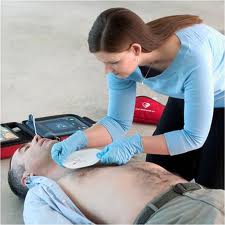Today's class was very laid back and knowledge-filled. We started off with our usual "oh-so-exciting" videos, which featured the lovely AED. I don't know what it is with lifeguarding and all these abbreviations, but like CPR from the other the AED is also a breeze! (or a shock! ha ha) For those of you who didn't know prior to reading this blog, an AED system stands for Automated External Defibrillator. Much like the machines shown on medical drama TV shows, and AED contains two paddles used to shock a victim's heart back to life. Unlike TV, however, an AED can't be charged multiple times and shocked at different frequencies. It's probably the most dangerous equipment we have dealt with thus far in my class. Once you learn what it is, it's pretty easy to figure how to use it, (especially when it verbally gives you directions) but here are a few tips from me.
- Dry off the victim with a towel or other cloth. Water is a good conductor of electricity and any damp spots left on the victim's chest could potentially hurt them.
- "Size up" your victim, so to speak. If they look big enough to stick both of the pads on the chest and side, proceed with normal protocol. If it looks like you won't be able to place them in the normal spots without them touching, place one on the front of the chest and one on the back.
- Check for body jewelry/piercings. If nipple rings interfere with the placement of the pads, DO NOT TAKE THEM OUT. It seems like the most common sense thing to do, but you may further injure the victim. Just place the pads around them.
- If other lifeguards are helping you, make sure to shout "Clear!" while the AED is analyzing the heart rate and while it is delivering shock. Check to make sure no one is touching the victim during either of these times.
- After the AED has done it's job and there is a pulse, continue on to CPR or ventilation.
That's mainly what I gathered from the AED lecture and we got to watch the instructors go through all the steps with a teacher's version of the AED that doesn't deliver a real shock. Next, we moved on to reviewing our CPR skills and we got time to practice whatever skills we wanted to on the dummies. I felt pretty confident about my CPR abilities, so I volunteered to go first when we started CPR checkoffs. This wasn't the final test for CPR, just a model for us to see how the real test would go and for the instructors to make sure we had been listening.
I was happy because I got to do mine with my favorite instructor (a young lady named Raquel). I ran through everything she told me to do and did really well. CPR is one part of the final test I'm not worried about. After check offs we got more time to practice CPR and then it was time to go.












